In the lush tropical streams of Australia and New Guinea, a small iridescent fish swiftly navigates through the vegetation, its vivid blue spots capturing attention. This captivating creature is the Spotted Blue-Eye Rainbowfish, scientifically identified as Pseudomugil gertrudae. Belonging to the Pseudomugilidae family, it shares close ties with other blue-eye species such as the Delicate Blue-Eye and Threadfin Rainbowfish.
Table of Contents
What makes the Spotted Blue-Eye so interesting is its captivating appearance packed into a diminutive size, typically maxing out around 1 inch long. The males in particular are spectacular, with rows of brilliant turquoise-blue spots adorning their sides. Hobbyists prize them as nano fish that bring a glimmer of living jewelry to small aquariums.
In the wild, schools of these surface-dwelling fish inhabit well-vegetated, slightly acidic waters. They mainly feed on small insects, zooplankton, and algae. Spotted Blue-Eyes are generally peaceful but males can be territorial with each other. In an aquarium setting, they do well in groups in densely planted tanks, ideally with a dark substrate to showcase their colors.
Spotted Blue-Eyes have been kept in the aquarium hobby since at least the 1930s, when they were first collected for the trade in New Guinea. Today, most specimens in the market are captive bred. They are sometimes sold under the names Gertrude’s Rainbowfish or Spotted Blue-Eye Pseudomugil.
Like many rainbowfish, Spotted Blue-Eyes exhibit interesting reproductive behaviors. Males intensify their colors and posture to impress females. Spawning occurs near the water’s surface, with females scattering adhesive eggs among fine-leaved plants which the male then guards. In a 2017 study published in the journal Behavioral Ecology, researchers found that male blue-eyes strategically court females in locations where their blue spots are accentuated by the background, likely to better attract mates.
While little Spotted Blue-Eyes may not have the same popularity as larger rainbowfishes, their charming looks, fascinating behaviors, and nano fish niche make them a compelling species for both beginning and veteran aquarists to appreciate. With proper care, a school of these living gems will shimmer in your tank for 3-5 years – a worthy addition to consider for your next aquarium!
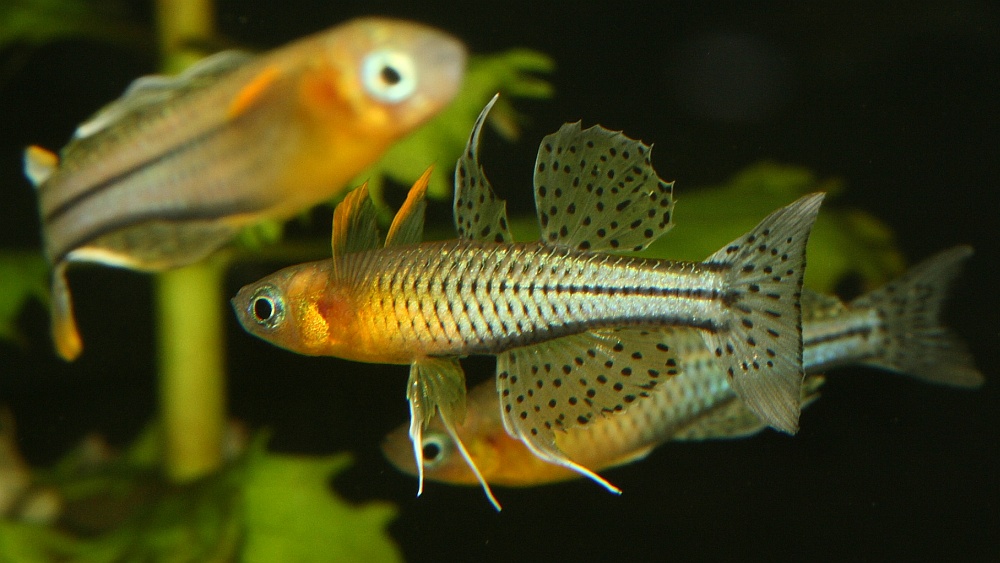
Spotted Blue-Eye Rainbowfish Key Information
The Spotted Blue-Eye Rainbowfish is a captivating species known for its vibrant coloration. Males showcase a series of brilliant, iridescent blue spots along their sides, which intensify during courtship displays. These spots contrast beautifully against the fish’s pale yellowish-olive body color. Females are less colorful, with a more silvery sheen and fewer, less prominent blue spots. The fins of both sexes are clear to yellowish, with the male’s fins being slightly more elongated and pointed.
| Family | Pseudomugilidae |
| Origin | Australia, New Guinea |
| Price | $5 – $15 per pair |
| Common Names | Gertrude’s Blue-Eye, Spotted Blue-Eye Pseudomugil |
| Variants | None recognized |
| Ideal Tank Size | 10 gallons or larger |
| Water Parameters | pH: 6.5-7.5, Temperature: 72-82°F (22-28°C) |
| Lifespan | 3-5 years |
| Full Size | 1 inch (2.5 cm) |
| Natural Environment | Well-vegetated, slightly acidic streams in tropical regions |
| Behavior | Peaceful, schooling fish; males can be territorial with each other |
| Habitat Preference | Top-dwelling, prefer densely planted areas |
| Aquarium Decoration | Densely planted with floating plants, dark substrate |
| Ideal Tank Mates | Other peaceful, similarly-sized fish like small tetras, rasboras, and other rainbowfish species |
| Fish to Avoid | Large, aggressive fish that may prey on or outcompete them |
| Best Foods/Diet | Small live or frozen foods like daphnia, cyclops, mosquito larvae; quality flake or micro pellets |
| Disease | Prone to common aquarium diseases if water quality is poor; sensitive to medications |
| Sex-Switch | No |
| Gender Differences | Males are more colorful with more prominent blue spots and slightly larger fins |
| Care Level | Easy to Moderate |
| Breeding Level | Moderate |
Ideal Tank Mates for Spotted Blue-Eye Rainbowfish
Choosing suitable tank mates for the Spotted Blue-Eye Rainbowfish (Pseudomugil gertrudae) requires careful evaluation of their water parameters, temperament, and size. It is essential to find companions that exude tranquility, exhibit no signs of aggression, and are small enough to ensure the safety of the smaller blue-eyes.
Spotted Blue-Eyes thrive in the company of their own species, so it’s best to keep them in groups of at least 6-8 individuals. This allows them to exhibit natural schooling behaviors and reduces aggression among males. Beyond their own kind, there are several other fish species that make excellent companions for these vibrant rainbowfish.
Here are 10 ideal tank mates for Spotted Blue-Eye Rainbowfish, along with their compatibility details:
1. Neon Tetras (Paracheirodon innesi)
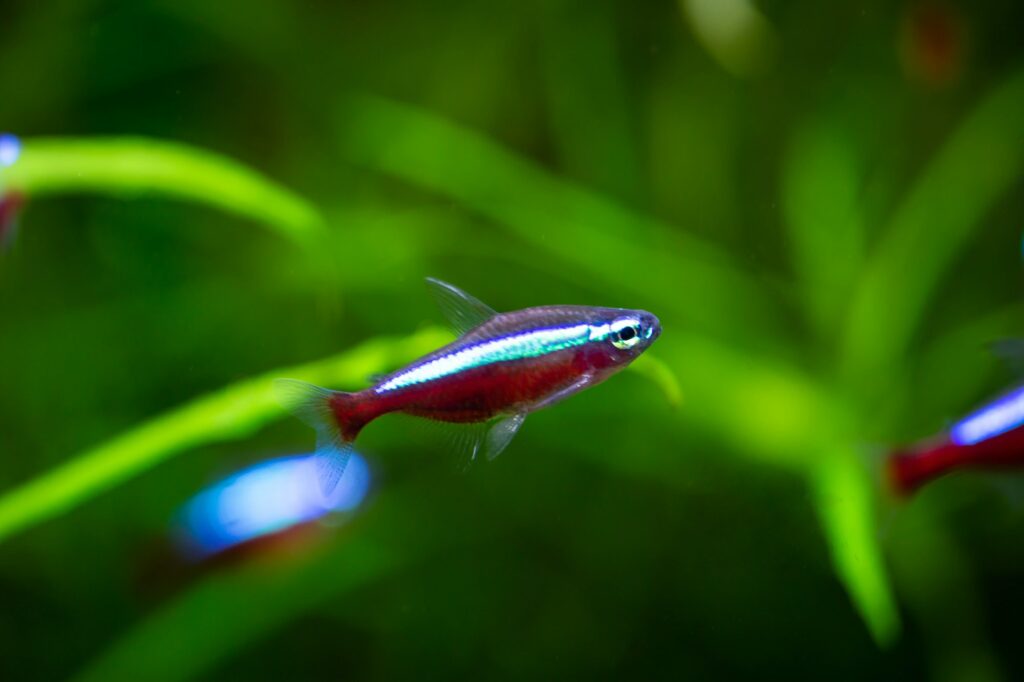
Neon Tetras are a classic nano fish that pair wonderfully with Spotted Blue-Eyes. Both species occupy different levels of the aquarium, with blue-eyes preferring the top and neons the middle, reducing competition for space. Neons are also peaceful schooling fish that won’t bother the shy blue-eyes.
| Common/Market Names | Neon Tetra |
| Price Range | $1 – $3 |
| Care Level | Easy |
| Behavior | Peaceful, Schooling |
| Life Span | 5-8 years |
| Max Size | 1.5 inches |
2. Pygmy Corydoras (Corydoras pygmaeus)
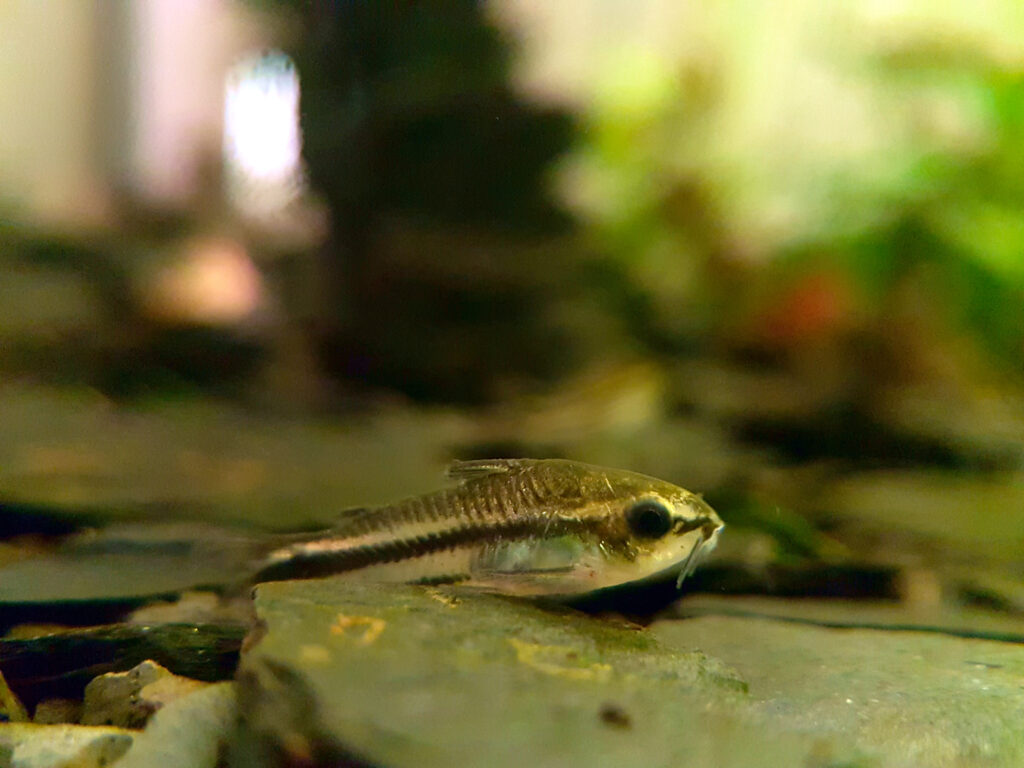
These tiny, peaceful bottom-dwellers are a perfect match for Spotted Blue-Eyes. Pygmy Corydoras occupy the lower levels of the tank, scavenging for leftover food and debris, while blue-eyes stick to the top. This creates a balanced eco-system in the aquarium.
| Common/Market Names | Pygmy Cory |
| Price Range | $3 – $6 |
| Care Level | Easy |
| Behavior | Peaceful, Schooling |
| Life Span | 3-5 years |
| Max Size | 1 inch |
3. Ember Tetras (Hyphessobrycon amandae)
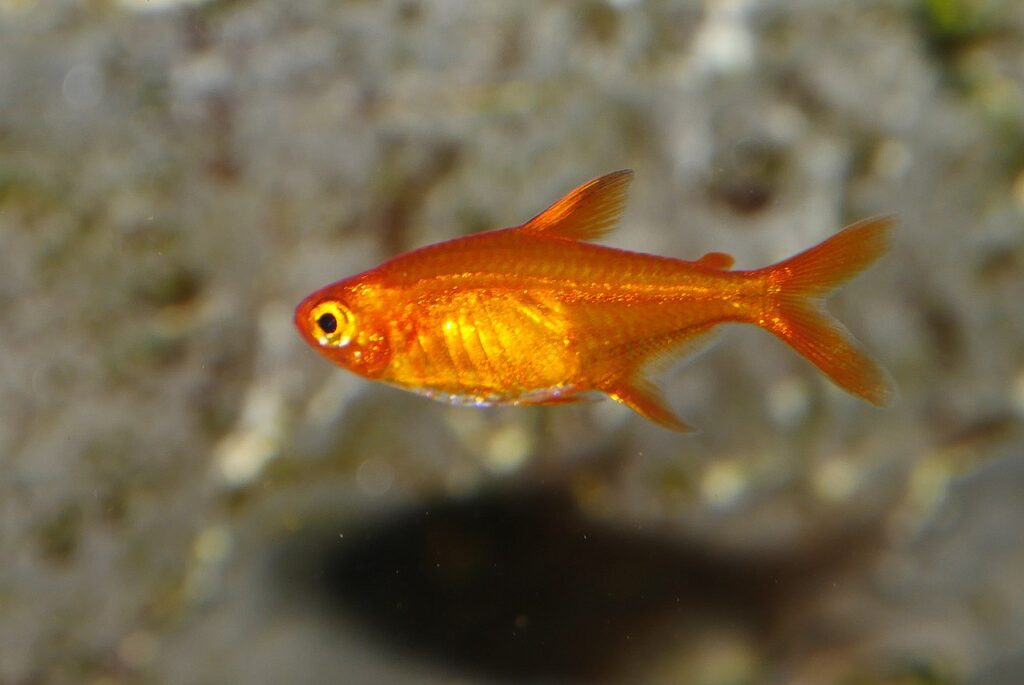
The bright orange coloration of Ember Tetras complements the blue hues of the Spotted Blue-Eyes, creating a visually stunning display. Like blue-eyes, Ember Tetras are peaceful nano fish that do well in planted aquariums.
| Common/Market Names | Ember Tetra |
| Price Range | $2 – $5 |
| Care Level | Easy |
| Behavior | Peaceful, Schooling |
| Life Span | 2-4 years |
| Max Size | 0.8 inch |
4. Celestial Pearl Danios (Danio margaritatus)
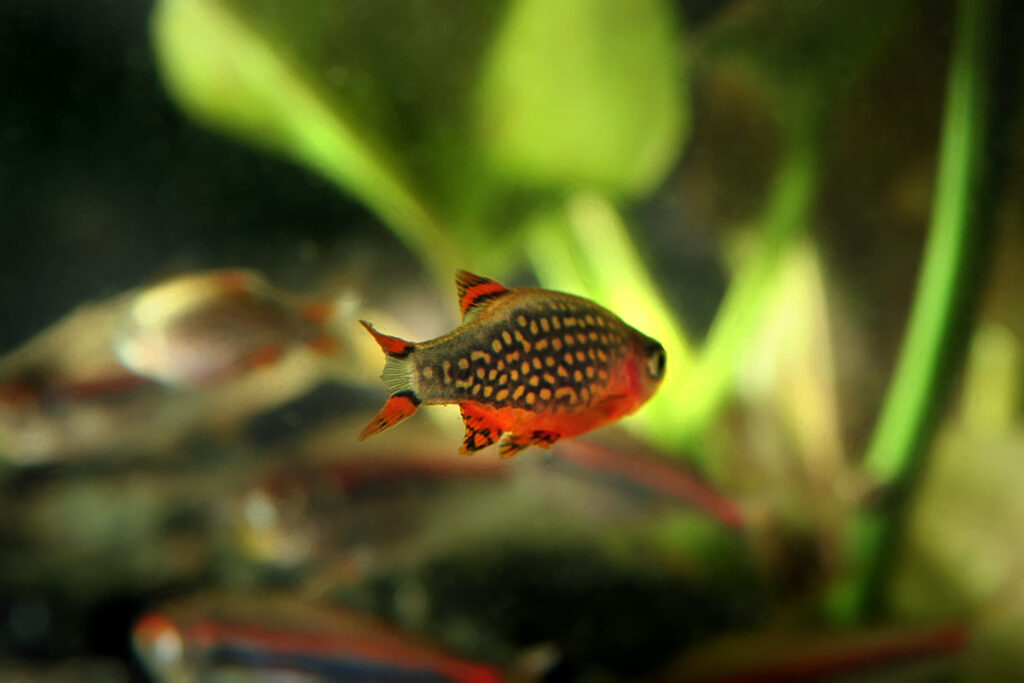
Celestial Pearl Danios, also known as Galaxy Rasboras, are another small, colorful species that coexist well with Spotted Blue-Eyes. Both fish appreciate densely planted tanks and will not compete for swimming space.
| Common/Market Names | Galaxy Rasbora, Microrasbora |
| Price Range | $5 – $10 |
| Care Level | Moderate |
| Behavior | Peaceful, Schooling |
| Life Span | 3-5 years |
| Max Size | 1 inch |
5. Endler’s Livebearers (Poecilia wingei)
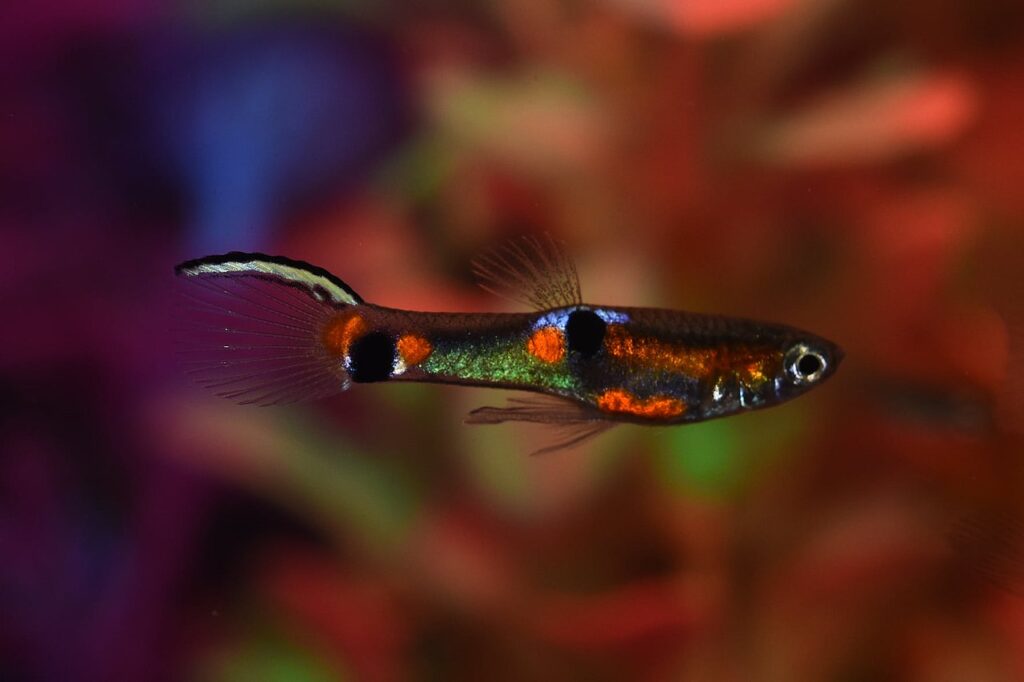
Endler’s Livebearers are small, colorful fish that add variety to a Spotted Blue-Eye tank. While Endlers prefer slightly harder, more alkaline water than blue-eyes, they can adapt to the soft, acidic conditions favored by rainbowfish.
| Common/Market Names | Endler’s Livebearer, Endler’s Guppy |
| Price Range | $3 – $8 |
| Care Level | Easy |
| Behavior | Peaceful, Active |
| Life Span | 2-3 years |
| Max Size | 1.8 inches |
6. Chili Rasboras (Boraras brigittae)
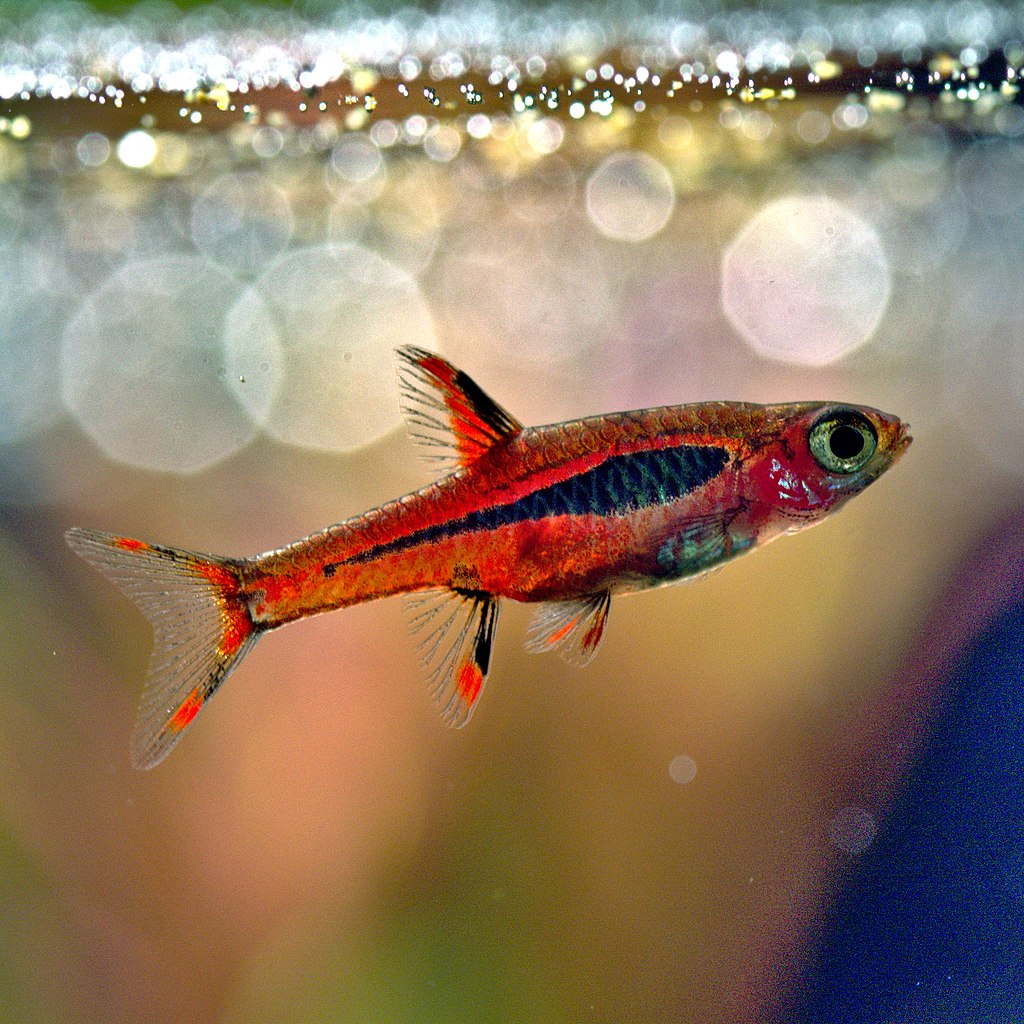
Chili Rasboras are tiny, vibrant red nano fish that share the same water preferences as Spotted Blue-Eyes. Both species enjoy heavily planted tanks and will not outcompete each other for food or space.
| Common/Market Names | Mosquito Rasbora |
| Price Range | $2 – $5 |
| Care Level | Moderate |
| Behavior | Peaceful, Schooling |
| Life Span | 4-8 years |
| Max Size | 0.7 inch |
7. Otocinclus Catfish (Otocinclus spp.)
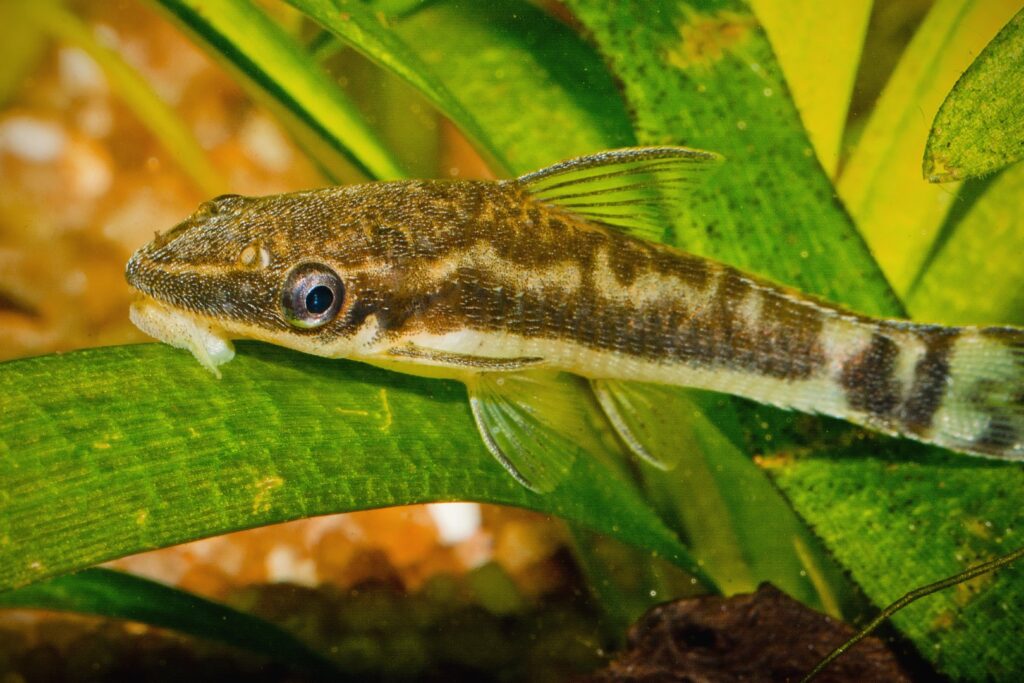
Otocinclus Catfish are small, algae-eating bottom dwellers that help keep the aquarium clean. Their peaceful nature and preference for lower tank levels make them ideal companions for Spotted Blue-Eyes.
| Common/Market Names | Oto, Dwarf Sucker Catfish |
| Price Range | $2 – $5 |
| Care Level | Easy to Moderate |
| Behavior | Peaceful, Schooling |
| Life Span | 3-5 years |
| Max Size | 2 inches |
8. Honey Gouramis (Trichogaster chuna)
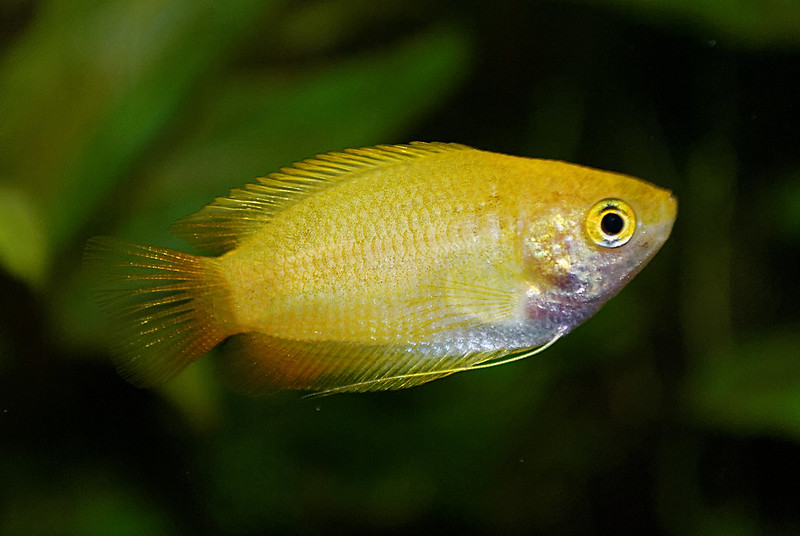
Honey Gouramis are small, peaceful labyrinth fish that inhabit the upper levels of the aquarium like Spotted Blue-Eyes. While slightly larger than blue-eyes, Honey Gouramis are not aggressive and will coexist harmoniously.
| Common/Market Names | Sunset Gourami, Red Honey Gourami |
| Price Range | $4 – $8 |
| Care Level | Easy |
| Behavior | Peaceful, can be territorial |
| Life Span | 4-8 years |
| Max Size | 2 inches |
9. Cherry Shrimp (Neocaridina davidi)
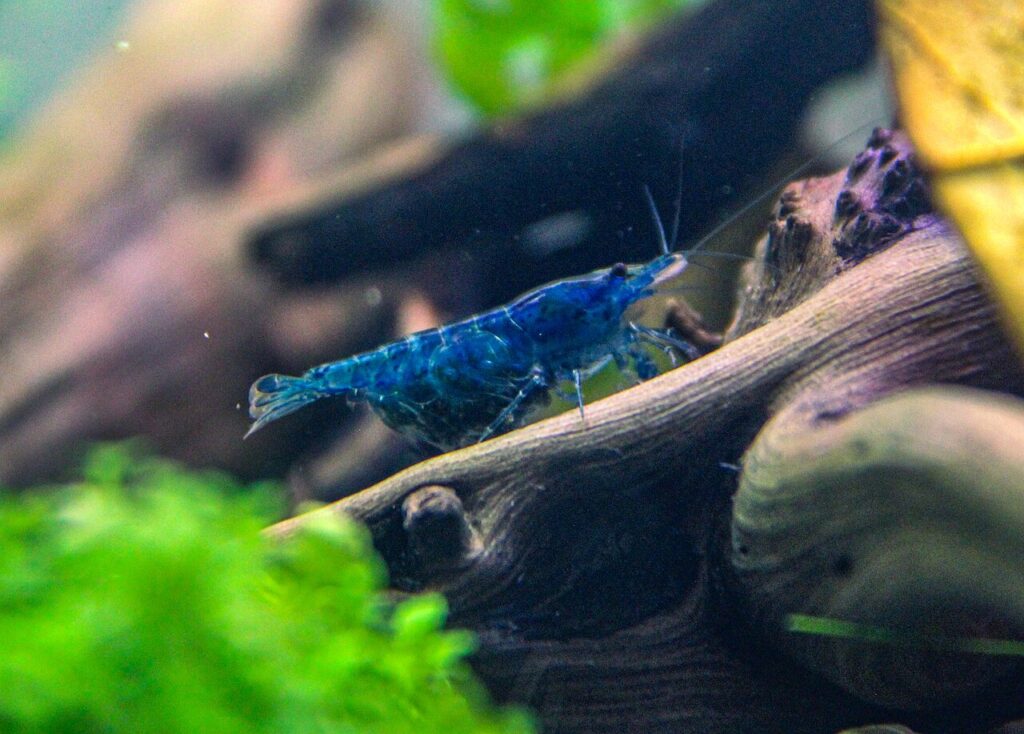
Cherry Shrimp are not fish, but they make excellent invertebrate tank mates for Spotted Blue-Eyes. These small, colorful shrimp help keep the aquarium clean by scavenging for leftover food and algae. Blue-eyes will not bother adult shrimp, but may prey on newly hatched shrimplets.
| Common/Market Names | Red Cherry Shrimp |
| Price Range | $2 – $6 |
| Care Level | Easy |
| Behavior | Peaceful, Shy |
| Life Span | 1-2 years |
| Max Size | 1.5 inches |
10. Kuhli Loaches (Pangio kuhlii)
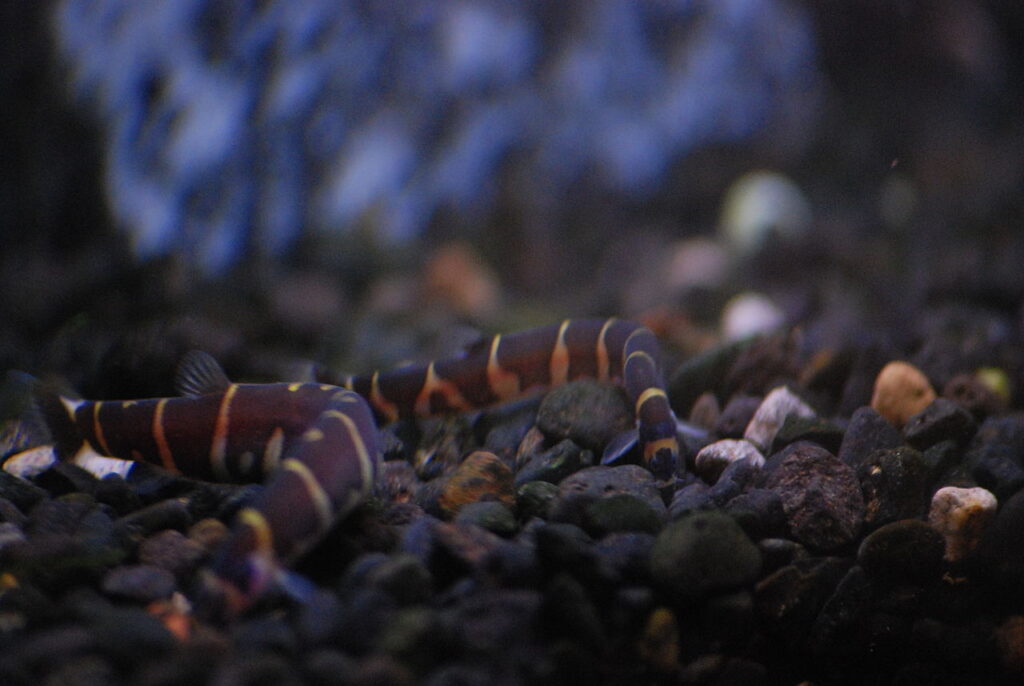
Kuhli Loaches are peaceful, eel-like bottom dwellers that add interest to the lower levels of the aquarium. They are nocturnal and will not compete with the diurnal Spotted Blue-Eyes for food or space.
| Common/Market Names | Coolie Loach |
| Price Range | $3 – $6 |
| Care Level | Easy |
| Behavior | Peaceful, Nocturnal |
| Life Span | 10+ years |
| Max Size | 4 inches |
When combining any of these species with Spotted Blue-Eye Rainbowfish, be sure to provide ample hiding spots, vegetation, and swimming space to ensure a harmonious, stress-free environment for all inhabitants.
FAQs about Spotted Blue-Eye Rainbowfish
How many Spotted Blue-Eye Rainbowfish should I keep together?
It’s best to keep Spotted Blue-Eye Rainbowfish in groups of at least 6-8 individuals. They are schooling fish that feel more secure and display more natural behaviors when kept in larger numbers. Keeping a balanced ratio of males to females, such as 1 male to 2-3 females, can also help minimize aggression among males.
What kind of filtration do Spotted Blue-Eye Rainbowfish need?
Spotted Blue-Eye Rainbowfish require clean, well-oxygenated water to thrive. A gentle sponge filter or small hang-on-back filter is suitable for their tanks. Avoid filters with strong currents, as these tiny fish prefer slower-moving water. Regular water changes of 10-20% per week are also essential to maintain good water quality.
Can Spotted Blue-Eye Rainbowfish be kept in a planted tank?
Yes, Spotted Blue-Eye Rainbowfish are excellent candidates for planted aquariums. They appreciate the cover and natural environment that live plants provide. Choose plants with fine leaves, such as Java Moss, Dwarf Hairgrass, or Microword, to mimic their natural habitat. Floating plants like Riccia or Frogbit are also beneficial, as they diffuse lighting and make the fish feel more secure.
Are Spotted Blue-Eye Rainbowfish jumpers?
Yes, Spotted Blue-Eye Rainbowfish are known to be skilled jumpers due to their active nature and surface-dwelling habits. To prevent them from jumping out of the tank, make sure to keep a tight-fitting lid on the aquarium at all times. You may also want to keep the water level a few inches below the top of the tank to provide an extra barrier.
How often should I feed Spotted Blue-Eye Rainbowfish?
Spotted Blue-Eye Rainbowfish have small stomachs and high metabolisms, so it’s best to feed them small amounts several times a day. Offer a variety of high-quality micro pellets, flakes, and small live or frozen foods like baby brine shrimp, daphnia, or cyclops. Avoid overfeeding, as excess food can quickly pollute the water in a nano tank.
Can Spotted Blue-Eye Rainbowfish be bred in captivity?
Yes, Spotted Blue-Eye Rainbowfish can be bred in the home aquarium with proper care and conditioning. They are egg scatterers that spawn among fine-leaved plants. To encourage spawning, provide a diet rich in live foods and slightly increase the water temperature. Remove the parents after spawning to prevent them from eating the eggs. The fry will hatch in about a week and should be fed infusoria or commercial fry food until they are large enough to accept baby brine shrimp.
Are Spotted Blue-Eye Rainbowfish suitable for beginners?
While Spotted Blue-Eye Rainbowfish are not the most difficult fish to keep, they may not be the best choice for absolute beginners due to their small size and specific water parameter requirements. They are sensitive to water quality fluctuations and may be easily outcompeted for food by larger or more boisterous tank mates. However, with proper research and care, moderately experienced aquarists can successfully keep and breed these colorful nano fish.